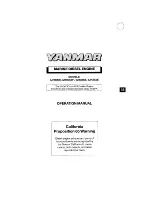
5A.11
Section 5A
LPG Fuel Systems
5A
Nikki Regulator Primary Chamber
(See Figure 5A-21)
The primary chamber reduces the high pressure fuel
flow from the tank and vaporizer down to
approximately 4 psi. Fuel flowing from the vaporizer
enters the inlet of the regulator under approximately
76 kPa (11 psi)
of pressure. There it is delivered to the
primary chamber
(3)
through the clearance between
the primary valve
(1)
and valve seat
(2)
. As fuel
continues to flow and the primary chamber
approaches
29 kPa (4 psi)
, the primary diaphragm
(4)
overcomes the tension of the diaphragm spring
(5)
. As
the diaphragm
(4)
and contact button
(6)
move up, the
primary lever spring
(8)
pushes the primary lever
(7)
up, in turn closing the primary valve
(1)
and stopping
the flow of fuel. As fuel is consumed and the pressure
in the primary chamber drops below
29 kPa (4 psi)
, the
diaphragm spring
(5)
tension will be greater than the
fuel pressure, causing the primary diaphragm
(4)
to be
pushed down. This causes the contact button
(6)
, to
push the primary lever
(7)
down, in turn opening the
primary valve
(1)
and admitting more fuel. In this
manner, the pressure within the primary chamber is
maintained at a relatively constant
29 kPa (4 psi)
.
Nikki Regulator Secondary Chamber
(See Figure 5A-22)
The secondary chamber further reduces the fuel
pressure from the
29 kPa (4 psi)
of the primary
chamber to near
0 kPa (0 psi)
pressure, to prevent
excessive fuel flow to the carburetor. Fuel enters the
secondary chamber
(13)
through the clearance
between the secondary valve
(11)
and the valve seat
(12)
. While the engine is operating, and fuel is being
drawn from the secondary chamber, the secondary
diaphragm
(14)
is raised by atmospheric pressure,
simultaneously lifting the secondary valve lever
(16)
,
opening the secondary valve
(11)
, allowing fuel to
flow. When the engine is running at idle, there may
not be enough vacuum created in the carburetor
venturi to overcome the tension of the secondary
diaphragm spring
(15)
, and the secondary diaphragm
cannot open the valve. Under those conditions, the
idle adjusting screw
(18)
, and balance spring
(19)
are
used to apply just enough pressure on the diaphragm
(14)
to maintain sufficient fuel flow for idle operation.
The vacuum lock-off mechanism is located in the
secondary chamber. When the engine is running,
manifold vacuum above the diaphragm
(17)
draws it
up, so the secondary valve can function normally.
When the engine is stopped, manifold vacuum is
terminated, and the diaphragm relaxes and pushes
down on the secondary valve lever, preventing any
fuel flow or leakage through the regulator.
11. Secondary Valve
16. Secondary Valve Lever
12. Secondary Valve Seat
17. Vacuum Lock-Off
13. Secondary Chamber
Diaphragm
14. Secondary Diaphragm
18. Idle Adjust Screw
15. Secondary Diaphragm Spring
19. Balance Spring
From Primary
Chamber
13
14
19
16
15
To
Carburetor
11
To Intake
Manifold
17
18
12
Figure 5A-22. Secondary Chamber.
Figure 5A-21. Primary Chamber.
1. Primary Valve
6. Contact Button
2. Primary Valve Seat
7. Primary Valve Lever
3. Primary Chamber
8. Primary Lever Spring
4. Primary Diaphragm
9. Primary Pressure
5. Primary Diaphragm Spring Adjustment
To Secondary Chamber
8
3
6
5
9
7
4
1
2
Fuel
Inlet
Summary of Contents for COMMAND CH18-CH26
Page 1: ...6 59 0 18 25 217 5 1 6 7 200 1 ...
Page 2: ......
Page 4: ......
Page 30: ...3 6 Section 3 Troubleshooting ...
Page 101: ......
Page 102: ......
Page 105: ......
Page 124: ... 6HFWLRQ XEULFDWLRQ 6 VWHP ...
Page 130: ...7 6 Section 7 Retractable Starter ...
Page 176: ... 6HFWLRQ OHFWULFDO 6 VWHP DQG RPSRQHQWV ...
Page 196: ...9 20 Section 9 Disassembly ...
Page 242: ... 6HFWLRQ 5HDVVHPEO ...
Page 245: ......
















































